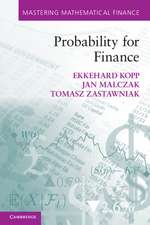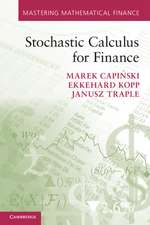Mathematics for Finance: An Introduction to Financial Engineering: Springer Undergraduate Mathematics Series
Autor Marek Capiński, Tomasz Zastawniaken Limba Engleză Paperback – 25 noi 2010
Din seria Springer Undergraduate Mathematics Series
-
 Preț: 319.90 lei
Preț: 319.90 lei -
 Preț: 237.41 lei
Preț: 237.41 lei -
 Preț: 319.02 lei
Preț: 319.02 lei -
 Preț: 325.20 lei
Preț: 325.20 lei -
 Preț: 238.28 lei
Preț: 238.28 lei -
 Preț: 237.29 lei
Preț: 237.29 lei -
 Preț: 265.92 lei
Preț: 265.92 lei -
 Preț: 236.87 lei
Preț: 236.87 lei -
 Preț: 236.97 lei
Preț: 236.97 lei -
 Preț: 240.63 lei
Preț: 240.63 lei -
 Preț: 237.18 lei
Preț: 237.18 lei -
 Preț: 283.11 lei
Preț: 283.11 lei -
 Preț: 359.15 lei
Preț: 359.15 lei -
 Preț: 358.55 lei
Preț: 358.55 lei -
 Preț: 221.92 lei
Preț: 221.92 lei -
 Preț: 224.54 lei
Preț: 224.54 lei -
 Preț: 358.82 lei
Preț: 358.82 lei -
 Preț: 301.10 lei
Preț: 301.10 lei -
 Preț: 383.17 lei
Preț: 383.17 lei -
 Preț: 229.86 lei
Preț: 229.86 lei -
 Preț: 268.37 lei
Preț: 268.37 lei -
 Preț: 166.75 lei
Preț: 166.75 lei -
 Preț: 239.86 lei
Preț: 239.86 lei -
 Preț: 266.70 lei
Preț: 266.70 lei -
 Preț: 269.99 lei
Preț: 269.99 lei - 15%
 Preț: 526.67 lei
Preț: 526.67 lei -
 Preț: 320.20 lei
Preț: 320.20 lei -
 Preț: 272.49 lei
Preț: 272.49 lei -
 Preț: 272.69 lei
Preț: 272.69 lei -
 Preț: 258.88 lei
Preț: 258.88 lei -
 Preț: 265.83 lei
Preț: 265.83 lei -
 Preț: 265.18 lei
Preț: 265.18 lei -
 Preț: 275.36 lei
Preț: 275.36 lei -
 Preț: 278.24 lei
Preț: 278.24 lei -
 Preț: 266.70 lei
Preț: 266.70 lei -
 Preț: 275.74 lei
Preț: 275.74 lei -
 Preț: 328.08 lei
Preț: 328.08 lei -
 Preț: 265.78 lei
Preț: 265.78 lei -
 Preț: 275.74 lei
Preț: 275.74 lei -
 Preț: 273.45 lei
Preț: 273.45 lei -
 Preț: 277.32 lei
Preț: 277.32 lei -
 Preț: 270.57 lei
Preț: 270.57 lei -
 Preț: 273.63 lei
Preț: 273.63 lei -
 Preț: 270.19 lei
Preț: 270.19 lei -
 Preț: 265.36 lei
Preț: 265.36 lei -
 Preț: 265.36 lei
Preț: 265.36 lei -
 Preț: 268.08 lei
Preț: 268.08 lei -
 Preț: 272.86 lei
Preț: 272.86 lei -
 Preț: 272.69 lei
Preț: 272.69 lei -
 Preț: 271.16 lei
Preț: 271.16 lei
Preț: 271.54 lei
Nou
Puncte Express: 407
Preț estimativ în valută:
51.98€ • 56.48$ • 43.69£
51.98€ • 56.48$ • 43.69£
Carte tipărită la comandă
Livrare economică 21 aprilie-05 mai
Preluare comenzi: 021 569.72.76
Specificații
ISBN-13: 9780857290816
ISBN-10: 0857290819
Pagini: 336
Ilustrații: XIII, 336 p. 66 illus.
Dimensiuni: 155 x 235 x 20 mm
Greutate: 0.45 kg
Ediția:2nd ed. 2011
Editura: SPRINGER LONDON
Colecția Springer
Seria Springer Undergraduate Mathematics Series
Locul publicării:London, United Kingdom
ISBN-10: 0857290819
Pagini: 336
Ilustrații: XIII, 336 p. 66 illus.
Dimensiuni: 155 x 235 x 20 mm
Greutate: 0.45 kg
Ediția:2nd ed. 2011
Editura: SPRINGER LONDON
Colecția Springer
Seria Springer Undergraduate Mathematics Series
Locul publicării:London, United Kingdom
Public țintă
Upper undergraduateCuprins
A Simple Market Model.- Risk-Free Assets.- Portfolio Management.- Forward and Futures Contracts.- Options: General Properties.- Binomial Model.- General Discrete Time Models.- Continuous Time Model.- Interest Rates.
Recenzii
From the reviews of the second edition:
“This second edition … is to start each chapter with the presentation of a case study and to end each chapter with a thorough discussion of that study. The authors also added new material on time-continuous models, along with the essentials of the mathematical arguments. … The current book is more substantial … . Summing Up: Recommended. Upper-division undergraduates and graduate students.” (D. Robbins, Choice, Vol. 48 (10), June, 2011)
“Throughout the text, the authors invite active reader participation. One way is by opening and closing each chapter with a case study. … authors have embedded all of the exercises in the discussion. … Solutions to all exercises appear in an appendix. This makes the book excellent for self-study. … this book provides an excellent introduction to financial engineering. … authors display impressive dexterity in ushering the reader from basics to an understanding of some of the deepest and most far-reaching ideas in the discipline.” (David A. Huckaby, The Mathematical Association of America, February, 2011)
“This second edition consists of standard topics for undergraduate level financial mathematics courses, plus an introduction to materials from an advanced level course. … Each chapter starts with a case study and ends with a discussion on it using the material taught in the chapter. In general this book provides many examples and exercises, which is very useful for helping readers to understand the materials covered. Overall this is a great book for upper level undergraduate students and those who want to self-study financial engineering.” (Youngna Choi, Mathematical Reviews, Issue 2012 e)
“This textbook presents … three major areas of mathematical finance at a level suitable for second or third year undergraduate students in mathematics, business management, finance or economics. … The text is interspersed with a multitude of elaborated examples and exercises, complete with solutions, providing ample material for tutorials as well as making the book good for self-study.” (Yuliya S. Mishura, Zentralblatt MATH, Vol. 1207, 2011)
“This second edition … is to start each chapter with the presentation of a case study and to end each chapter with a thorough discussion of that study. The authors also added new material on time-continuous models, along with the essentials of the mathematical arguments. … The current book is more substantial … . Summing Up: Recommended. Upper-division undergraduates and graduate students.” (D. Robbins, Choice, Vol. 48 (10), June, 2011)
“Throughout the text, the authors invite active reader participation. One way is by opening and closing each chapter with a case study. … authors have embedded all of the exercises in the discussion. … Solutions to all exercises appear in an appendix. This makes the book excellent for self-study. … this book provides an excellent introduction to financial engineering. … authors display impressive dexterity in ushering the reader from basics to an understanding of some of the deepest and most far-reaching ideas in the discipline.” (David A. Huckaby, The Mathematical Association of America, February, 2011)
“This second edition consists of standard topics for undergraduate level financial mathematics courses, plus an introduction to materials from an advanced level course. … Each chapter starts with a case study and ends with a discussion on it using the material taught in the chapter. In general this book provides many examples and exercises, which is very useful for helping readers to understand the materials covered. Overall this is a great book for upper level undergraduate students and those who want to self-study financial engineering.” (Youngna Choi, Mathematical Reviews, Issue 2012 e)
“This textbook presents … three major areas of mathematical finance at a level suitable for second or third year undergraduate students in mathematics, business management, finance or economics. … The text is interspersed with a multitude of elaborated examples and exercises, complete with solutions, providing ample material for tutorials as well as making the book good for self-study.” (Yuliya S. Mishura, Zentralblatt MATH, Vol. 1207, 2011)
Notă biografică
Marek Capinski is Professor of Mathematics at AGH University of Science and Technology, Poland.
Tomasz Zastawniak is Professor of Mathematics at the University of York, UK.
Textul de pe ultima copertă
As with the first edition, Mathematics for Finance: An Introduction to Financial Engineering combines financial motivation with mathematical style. Assuming only basic knowledge of probability and calculus, it presents three major areas of mathematical finance, namely option pricing based on the no-arbitrage principle in discrete and continuous time setting, Markowitz portfolio optimisation and the Capital Asset Pricing Model, and basic stochastic interest rate models in discrete setting.
In this second edition, the material has been thoroughly revised and rearranged. New features include:
• A case study to begin each chapter – a real-life situation motivating the development of theoretical tools;
• A detailed discussion of the case study at the end of each chapter;
• A new chapter on time-continuous models with intuitive outlines of the mathematical arguments and constructions;
• Complete proofs of the two fundamental theorems of mathematical finance in discrete setting.
From the reviews of the first edition:
”This text is an excellent introduction to Mathematical Finance. Armed with a knowledge of basic calculus and probability a student can use this book to learn about derivatives, interest rates and their term structure and portfolio management.”(Zentralblatt MATH)
”Given these basic tools, it is surprising how high a level of sophistication the authors achieve, covering such topics as arbitrage-free valuation, binomial trees, and risk-neutral valuation.” (www.riskbook.com)
”The reviewer can only congratulate the authors with successful completion of a difficult task of writing a useful textbook on a traditionally hard topic.” (K. Borovkov, The Australian Mathematical Society Gazette, Vol. 31 (4), 2004)
In this second edition, the material has been thoroughly revised and rearranged. New features include:
• A case study to begin each chapter – a real-life situation motivating the development of theoretical tools;
• A detailed discussion of the case study at the end of each chapter;
• A new chapter on time-continuous models with intuitive outlines of the mathematical arguments and constructions;
• Complete proofs of the two fundamental theorems of mathematical finance in discrete setting.
From the reviews of the first edition:
”This text is an excellent introduction to Mathematical Finance. Armed with a knowledge of basic calculus and probability a student can use this book to learn about derivatives, interest rates and their term structure and portfolio management.”(Zentralblatt MATH)
”Given these basic tools, it is surprising how high a level of sophistication the authors achieve, covering such topics as arbitrage-free valuation, binomial trees, and risk-neutral valuation.” (www.riskbook.com)
”The reviewer can only congratulate the authors with successful completion of a difficult task of writing a useful textbook on a traditionally hard topic.” (K. Borovkov, The Australian Mathematical Society Gazette, Vol. 31 (4), 2004)
Caracteristici
A case study to begin each chapter – a real-life situation motivating the development of theoretical tools A detailed discussion of the case study at the end of each chapter A new chapter on time-continuous models with intuitive outlines of the mathematical arguments and constructions Complete proofs of the two fundamental theorems of mathematical finance in discrete setting Includes supplementary material: sn.pub/extras











